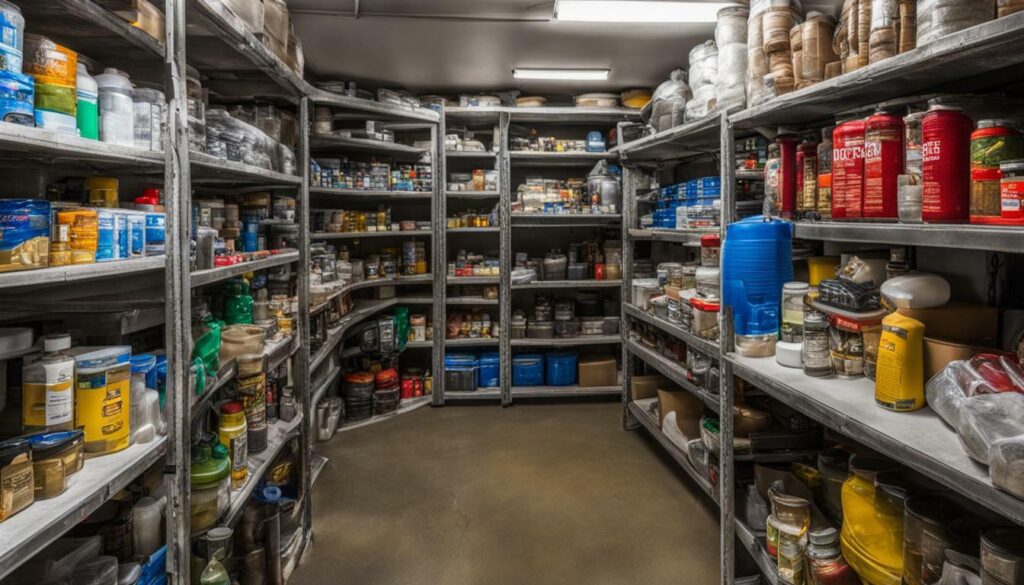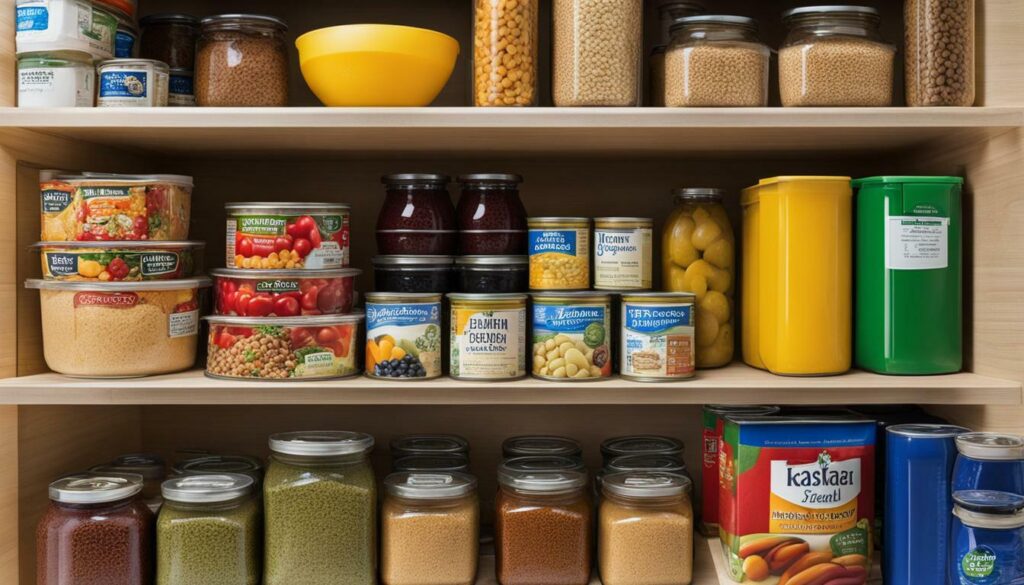

Welcome to my comprehensive guide on meat preservation, where I’ll take you on a journey through various food preservation techniques and provide you with practical meat storage ideas to ensure your meals are always fresh and delicious.
Key Takeaways:
- Meat preservation is crucial for long-lasting storage and maintaining the quality of your meat.
- Methods such as freezing, canning, curing, smoking, and vacuum sealing can help preserve meat effectively.
- Proper techniques and guidelines should be followed to ensure the safety and flavor of preserved meats.
- Additional preservation methods are available for game meats and fish, including pickling and corning.
- Exploring different meat drying techniques can provide delicious and safe options for preserving meat.
In this guide, we will explore the principles of meat preservation and delve into the processes of freezing, canning, curing, smoking, and other preservation methods. By the end, you’ll have a comprehensive understanding of how to preserve your meat in various ways, ensuring its longevity and delectable taste.
Understanding the Principles of Meat Preservation
Before diving into the different meat preservation methods, it’s important to understand the fundamental principles behind preserving meat, such as curing and drying, which play a crucial role in maintaining its quality and flavor. By utilizing these techniques, you can extend the shelf life of meat while enhancing its taste.
Curing is a process that involves the addition of salt, sugar, nitrates, and other ingredients to meat. This helps to slow down the growth of bacteria and inhibit spoilage. Curing can be done through wet curing, where the meat is soaked in a brine solution, or by using dry curing methods, which involve the application of a dry rub or mixture directly onto the meat. The curing process not only preserves the meat but also imparts a unique and delicious flavor.
Drying is another key method of meat preservation. By removing moisture from the meat, bacteria growth is inhibited, preventing spoilage. Air drying and dehydrating are common techniques used to dry meat. Air drying involves hanging the meat in a cool, dry place with good air circulation. Dehydrating, on the other hand, uses low heat and airflow to gradually remove moisture from the meat. Both methods result in a lightweight, shelf-stable product that can be stored for an extended period of time.
| Technique | Preservation Method | Flavor Profile |
|---|---|---|
| Curing | Addition of salt, sugar, nitrates, etc. | Enhances and develops unique flavors |
| Drying | Removal of moisture through air drying or dehydrating | Concentrates flavors, resulting in a rich and intense taste |
Now that you have a better understanding of the principles of meat preservation, you can explore the different methods in more detail. Whether you choose to freeze, can, cure, smoke, or dry your meat, each technique offers its own benefits and can result in delicious, long-lasting preservation. The key is to select the method that best suits your needs and preferences, ensuring that your preserved meat remains safe and flavorful for future enjoyment.
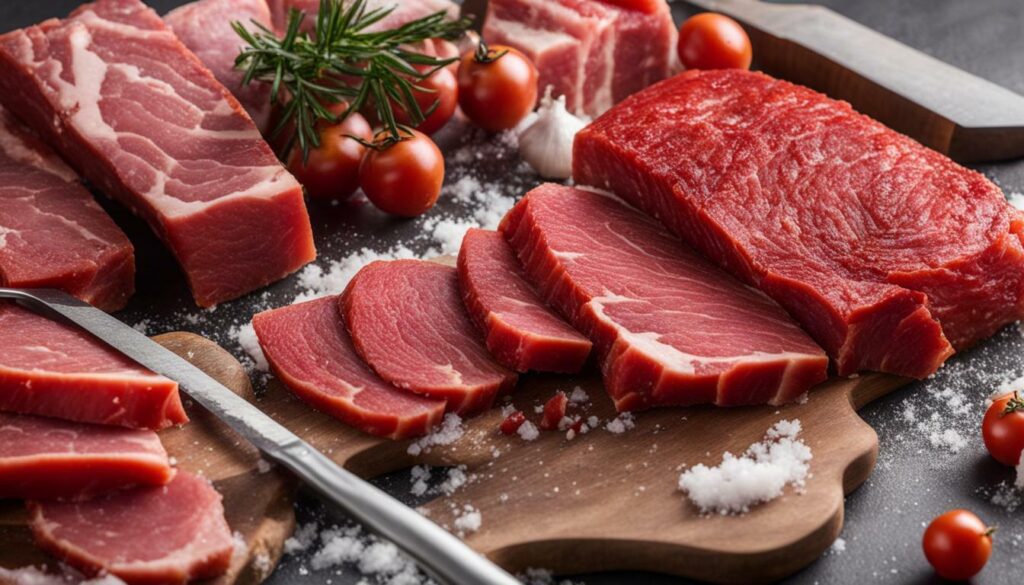

Freezing is one of the simplest and most effective methods of meat preservation, allowing you to extend its shelf life while retaining its taste and texture. Let’s delve into the process of freezing meat and discover the advantages of freeze drying.
When freezing meat, it’s crucial to start with high-quality, fresh meat. Trim away excess fat and divide large cuts into smaller portions for easier handling. For optimal preservation, wrap the meat tightly in freezer-safe packaging, such as heavy-duty plastic bags or freezer paper, removing as much air as possible. This prevents freezer burn and maintains the quality of the meat.
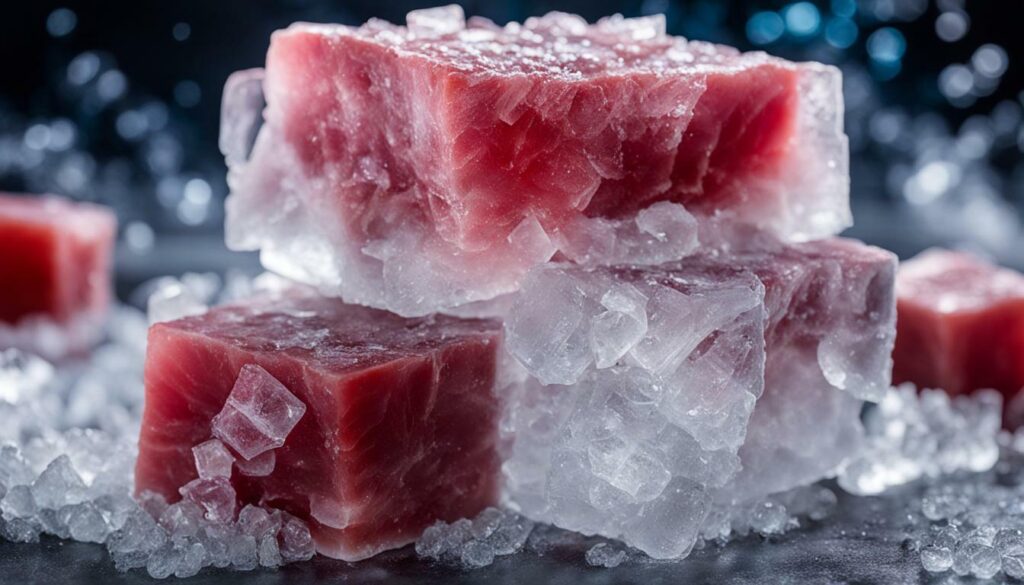

One method of freezing that has gained popularity in recent years is freeze drying. This process involves freezing the meat at extremely low temperatures and then slowly removing the moisture through sublimation. Freeze drying helps to preserve the texture, flavor, and nutritional value of the meat, making it a popular choice for prepackaged meals and emergency food supplies.
Advantages of Freeze Drying
- Long Shelf Life: Freeze-dried meat can last for several years when stored properly, making it an excellent option for long-term food storage.
- Nutritional Value: Freeze drying retains the majority of the meat’s nutrients, ensuring that you can enjoy a nutritious meal even in emergencies.
- Convenience: Freeze-dried meat is lightweight, compact, and easy to rehydrate, making it a convenient option for outdoor activities like camping or hiking.
By harnessing the power of freezing and freeze drying, you can confidently preserve your meat supply while maintaining its taste, texture, and nutritional value. Whether you’re planning for long-term storage or looking for a convenient option for outdoor adventures, freezing is a practical and effective method of meat preservation.
Canning: Preserving Meat in Jars for Longevity
If you’re looking for a way to preserve meat for an extended period, canning is a fantastic option. In this section, we’ll explore the meat canning process and guide you through each step to ensure your preserved meats stay fresh and delicious. Canning is a popular method that involves sealing meat in jars to prevent spoilage and extend its shelf life.


The first step in the meat canning process is to prepare your meat. Choose fresh, high-quality cuts and trim away any excess fat. It’s important to handle the meat safely and ensure it is cooked thoroughly before canning. This helps eliminate any potential bacteria that could lead to spoilage.
Next, you’ll need to pack the meat into sterilized jars. This ensures that no bacteria or contaminants are present, which could compromise the preservation process. It’s essential to follow proper canning procedures, including using the right jar sizes, leaving the appropriate headspace, and using a pressure canner or boiling water bath, depending on the type of meat being canned.
Once the jars are packed and sealed, they need to be processed to kill any remaining bacteria and create a vacuum seal. This can be done through pressure canning or boiling water bath canning, depending on the acidity of the meat being preserved. The processing time and method will vary depending on the type of meat and the altitude at which you are canning.
Tips for Successful Meat Canning
- Always use reliable and up-to-date canning recipes and guidelines to ensure proper food safety.
- Invest in a good-quality pressure canner or boiling water bath canner to ensure accurate processing.
- Label your canned meats with the date and contents to keep track of their freshness.
- Store your canned meats in a cool, dry, and dark place to maintain their quality.
By following the meat canning process carefully and using proper techniques, you can enjoy the benefits of preserved meat for months or even years. Whether you’re stocking up for emergencies or simply want to savor the flavors of your favorite meats all year round, canning provides a safe and effective preservation method.
| Type of Meat | Recommended Canning Method | Processing Time (at sea level) |
|---|---|---|
| Beef | Pressure canning | 75 minutes for pints, 90 minutes for quarts |
| Poultry | Pressure canning or boiling water bath canning | 75 minutes for pints, 90 minutes for quarts |
| Pork | Pressure canning | 75 minutes for pints, 90 minutes for quarts |
| Lamb | Pressure canning or boiling water bath canning | 75 minutes for pints, 90 minutes for quarts |
Curing: Infusing Meat with Delectable Flavors
Curing meat is a time-honored technique that not only preserves it but also imparts incredible flavors. Join me as we explore various meat curing methods, with a special emphasis on the art of salt curing.
One of the oldest and most popular curing methods is salt curing. This process involves coating the meat with salt and allowing it to dry. The salt draws out moisture, creating an inhospitable environment for bacteria and microorganisms that cause spoilage. As the meat dries, it becomes more concentrated in flavor, resulting in a rich and savory taste.
To salt cure meat, start by choosing a high-quality cut such as pork belly or beef brisket. Rub the meat thoroughly with a mixture of salt, sugar, and any desired herbs and spices. Place it in a container and refrigerate for several days, allowing the salt to penetrate and work its magic. Rinse off the excess salt, pat dry, and hang the meat in a cool, well-ventilated area to dry further. The result? A beautifully cured piece of meat ready to be enjoyed in a variety of dishes.


| Benefits of Salt Curing | Considerations |
|---|---|
|
|
While salt curing is a traditional method, it’s important to note that curing meat at home requires careful attention to food safety. Follow proper curing techniques, such as using the right amount of salt, refrigerating at the correct temperature, and monitoring the curing process closely to avoid the risk of foodborne illnesses.
Other Meat Curing Methods
Aside from salt curing, there are other methods to explore. Some popular ones include:
- Sugar curing: Similar to salt curing, this method involves using sugar as the primary curing agent. It imparts a slightly sweeter flavor to the meat.
- Smoking: Combining the preservation benefits of curing with the aromatic flavors of smoking, this method involves exposing the meat to smoke from burning wood or charcoal.
- Nitrates and nitrites: These compounds are commonly used in commercial meat products for curing and preserving. However, they should be used cautiously and in accordance with safety guidelines due to their potential health risks.
With the array of curing methods available, you have the freedom to experiment and create unique flavors that suit your taste preferences. Just remember to prioritize food safety and enjoy the process of preserving and savoring meat in a whole new way!
Smoking: Enhancing Preservation with Delectable Smoky Flavors
If you’ve ever savored the mouthwatering taste of smoked meat, you know the incredible flavor it brings. In this section, we’ll explore the meat smoking process, from selecting the right wood to mastering the perfect smoky flavors.
When it comes to smoking meat, the choice of wood plays a crucial role in creating the desired flavors. Different types of wood, such as hickory, mesquite, apple, and cherry, impart unique smoky profiles to your meat. Experimenting with different wood flavors can elevate your culinary creations to new heights.
The smoking process involves slow-cooking meat at low temperatures for an extended period. This helps in tenderizing the meat and infusing it with rich smoky flavors. Whether you’re smoking pork ribs, beef brisket, or chicken wings, the key is to maintain a consistent temperature using a high-quality smoker or grill.
One important aspect of meat smoking is the use of rubs and marinades. These flavorful mixtures, typically made with spices, herbs, and other seasonings, add an extra layer of complexity to the meat. Applying the rub or marinade before smoking allows the flavors to penetrate the meat, enhancing its taste and tenderness.
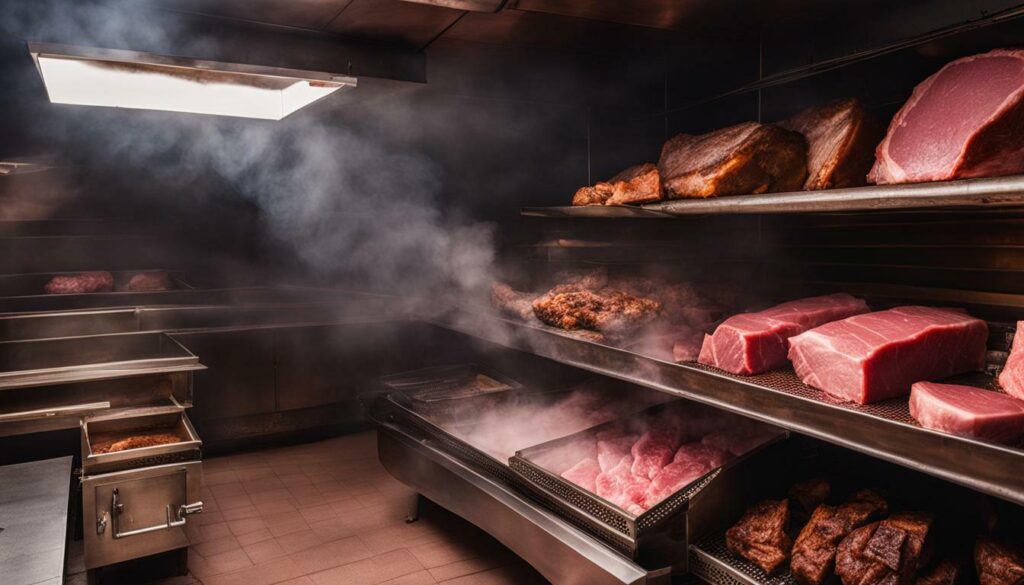

To achieve the perfect smoky flavors, it’s crucial to be patient and give the meat enough time to absorb the smoke. Slow and steady wins the race when it comes to smoking meat. Keep track of the internal temperature of the meat and use a meat thermometer to ensure it reaches the desired level of doneness.
Whether you’re a seasoned pitmaster or just starting on your smoking journey, exploring different smoking techniques and recipes can expand your culinary horizons. From traditional Texas-style barbecue to mouthwatering smoked salmon, there are endless possibilities to explore and savor.
Types of Wood for Smoking
When it comes to selecting the right wood for smoking, it’s essential to choose wisely. Each type of wood imparts a distinct flavor to the meat. Here are some popular choices:
- Hickory: Known for its strong and smoky flavor, hickory is a popular choice for smoking meats like pork ribs and beef brisket.
- Mesquite: Mesquite wood gives a bold, earthy flavor to meats. It pairs well with rich and fatty meats like beef and lamb.
- Apple: Applewood offers a subtle and slightly sweet flavor, making it ideal for smoking poultry and pork.
- Cherry: Cherry wood adds a mild and fruity flavor to meats, complementing dishes like smoked ham and chicken.
Experimenting with different wood flavors will allow you to tailor the smoky taste to your personal preference. Whether you prefer a robust and bold flavor or a more delicate and subtle taste, there’s a wood out there to suit your needs.
Expert Tip: Let the Smoke Shine
If you want the smoky flavors to shine through, avoid overpowering the meat with excessive seasoning or heavy sauces. Keep it simple and let the natural flavors of the meat and the smoke take center stage.
| Wood Type | Flavor Profile | Best Matches |
|---|---|---|
| Hickory | Strong and smoky | Pork ribs, beef brisket |
| Mesquite | Bold and earthy | Beef, lamb |
| Apple | Subtle and slightly sweet | Poultry, pork |
| Cherry | Mild and fruity | Smoked ham, chicken |
Vacuum Sealing: An Airtight Solution for Extended Preservation
Vacuum sealing has become increasingly popular for preserving meat, and for good reason. Join me as we explore the advantages of vacuum sealing meat and discover the step-by-step process to ensure your preserved meats stay fresh for longer.
When it comes to meat preservation, vacuum sealing offers several key benefits. Firstly, it creates an airtight seal that prevents the entry of oxygen, which is the main culprit behind spoilage and freezer burn. By removing the air from the packaging, vacuum sealing helps maintain the quality and flavor of the meat, keeping it tender and juicy.
Not only does vacuum sealing prolong the shelf life of your preserved meat, but it also allows for convenient storage. By compressing the packaging, vacuum sealing reduces the amount of space needed in your freezer or pantry. This is especially useful when you have limited storage space or are looking to stock up on meats during sales or hunting seasons.
To vacuum seal your meat, you’ll need a vacuum sealer machine and vacuum-seal bags or rolls. Start by cutting a piece of bag or roll large enough to hold your meat, leaving some extra space for sealing. Place the meat inside the bag, making sure it’s dry and free from excess moisture.
| Steps for Vacuum Sealing Meat |
|---|
| 1. Place the meat inside a vacuum-seal bag or roll. |
| 2. Ensure the bag is large enough and leave space for sealing. |
| 3. Place the open end of the bag onto the vacuum sealer machine. |
| 4. Press the “vacuum seal” or “start” button to activate the machine. |
| 5. Allow the machine to remove the air and seal the bag. |
| 6. Once the process is complete, remove the sealed bag from the machine. |
| 7. Label the bag with the type of meat and date of sealing. |
| 8. Store the vacuum-sealed meat in the freezer or pantry. |
By following these simple steps, you can enjoy the benefits of vacuum sealing for your preserved meats. Remember to label your sealed bags with the type of meat and date of sealing for easy identification. Whether you’re preserving game meats, marinating steaks, or storing leftovers, vacuum sealing is a reliable and effective method for extending the shelf life of your meat.


- Vacuum sealing meat offers advantages such as preserving quality, preventing spoilage, and saving storage space.
- To vacuum seal meat, you’ll need a vacuum sealer machine and vacuum-seal bags or rolls.
- Follow the step-by-step process of placing the meat in the bag, sealing it with the machine, and labeling for easy identification.
- Vacuum-sealed meat can be safely stored in the freezer or pantry for extended periods.
Explore the World of Meat Drying Techniques
Drying meat is a traditional preservation method that has stood the test of time. In this section, we’ll delve into the world of meat drying techniques, exploring both air drying and dehydrating methods to ensure your preserved meats are packed with flavor.
When it comes to air drying, the process involves hanging meat in a well-ventilated, cool, and dry space. This allows the moisture in the meat to slowly evaporate, resulting in a concentrated and intense flavor. Air drying is commonly used for making jerky, a popular snack that is both delicious and shelf-stable. The process involves marinating thinly sliced meat in a flavorful mixture, then hanging it to dry until it reaches the desired texture and taste.
On the other hand, dehydrating meat involves the use of a food dehydrator or an oven set at a low temperature. This method removes moisture rapidly, preserving the meat while retaining its natural flavors. Dehydrated meat, such as beef or turkey jerky, is a convenient and portable snack that can be enjoyed on the go. It’s important to ensure the meat is fully dehydrated to prevent any bacterial growth, so follow the manufacturer’s instructions or refer to reliable resources for specific drying times.
Whether you prefer the slow and steady process of air drying or the convenience of using a dehydrator, both methods offer a flavorful way to preserve your meats. Experiment with different seasonings and spices to enhance the taste, and remember to properly store your dried meats in airtight containers or vacuum-sealed bags to maintain their quality and extend their shelf life.
Table 1: Pros and Cons of Air Drying and Dehydrating
| Methods | Pros | Cons |
|---|---|---|
| Air Drying |
|
|
| Dehydrating |
|
|
Quote
“Preserving meat through drying not only extends its shelf life but also intensifies its flavors. With the right techniques, you can create delicious and nutritious snacks that will keep you satisfied on your outdoor adventures or whenever hunger strikes.
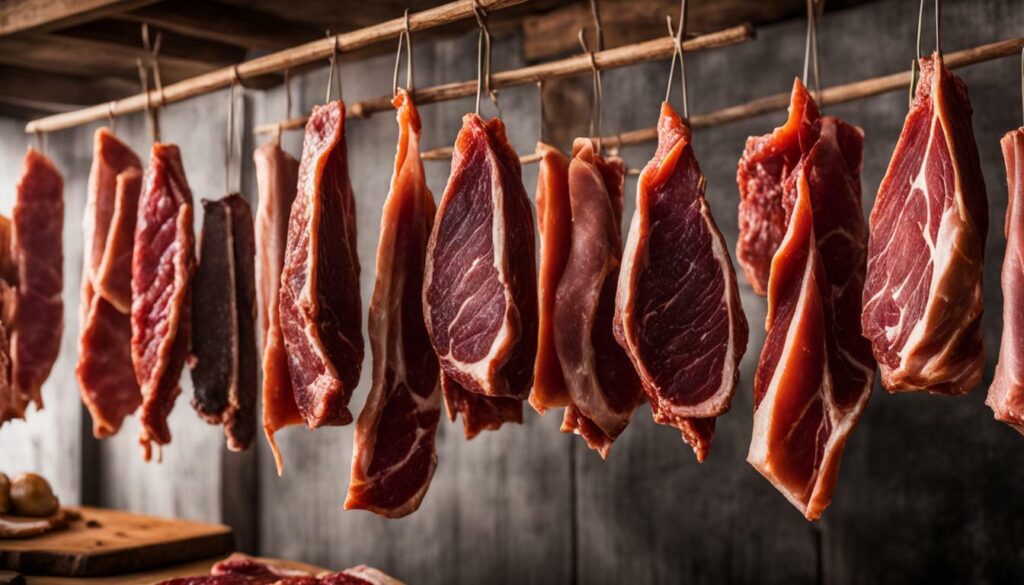

At the end of the section, I added a table that summarizes the pros and cons of air drying and dehydrating methods. This will provide readers with a quick reference to help them decide which method suits their needs best.
Preserving game meats and fish presents unique challenges, but fear not, as I’m here to guide you through additional preservation methods specifically tailored for these meats. Join me as we explore pickling, corning, and more.
One popular method for preserving game meats and fish is pickling. Pickling not only extends the shelf life of these meats but also imparts a tangy and flavorful taste. To pickle game meats and fish, start by combining equal parts vinegar and water in a pot. Add spices like peppercorns, mustard seeds, and bay leaves for added flavor. Bring the mixture to a boil, then pour it over the meat or fish in sterilized jars. Seal the jars tightly and store them in a cool, dark place for several weeks to allow the flavors to develop. Pickled game meats and fish make for a delicious addition to sandwiches, salads, and antipasto platters.
Another preservation method that works well for game meats and fish is corning. Corning involves curing the meat or fish in a mixture of salt, sugar, and spices, such as cloves and allspice. This process not only enhances the flavor but also helps to preserve the meat. To corn game meats or fish, prepare a brine by dissolving salt, sugar, and spices in water. Submerge the meat or fish in the brine and refrigerate for several days or up to a week. Rinse the meat or fish thoroughly before cooking or smoking. The corned game meats and fish are perfect for a traditional Irish meal or a hearty sandwich.
Don’t forget about smoking as a preservation method for game meats and fish. Smoking not only imparts a rich and smoky flavor but also helps to extend the shelf life of the meat. To smoke game meats or fish, start by preparing a mixture of wood chips and water. Soak the wood chips for at least 30 minutes to an hour to ensure a steady smoke. Next, create a low and steady fire in your smoker or grill. Once the fire is established, place the game meats or fish on the smoking racks and close the lid. Allow the meat or fish to smoke for several hours until it reaches the desired level of smokiness. Smoked game meats and fish are versatile ingredients that can be used in a variety of dishes, from pasta to tacos.
As you can see, there are several additional preservation methods for game meats and fish beyond the traditional freezing, curing, and canning. Pickling, corning, and smoking offer unique flavors and textures while keeping your meats and fish safe for long-term storage. Experiment with these methods to discover new ways to enjoy your favorite game meats and fish throughout the year.
| Pickling | Corning | Smoking |
|---|---|---|
| Pickling preserves meats and fish by immersing them in a mixture of vinegar, water, and spices. | Corning cures meats and fish by submerging them in a brine of salt, sugar, and spices. | Smoking adds a smoky flavor to meats and fish while also helping to extend their shelf life. |
| Requires boiling vinegar and water mixture before pouring it over meats or fish in sterilized jars. | Requires preparing a brine with salt, sugar, spices, and submerging meats or fish in it for several days. | Requires soaking wood chips in water and smoking meats or fish over a low, steady fire for several hours. |
| Results in tangy and flavorful meats or fish that can be used in sandwiches, salads, or antipasto platters. | Results in flavorful and tender meats or fish that are perfect for traditional Irish meals or sandwiches. | Results in rich and smoky meats or fish that can be used in a variety of dishes. |
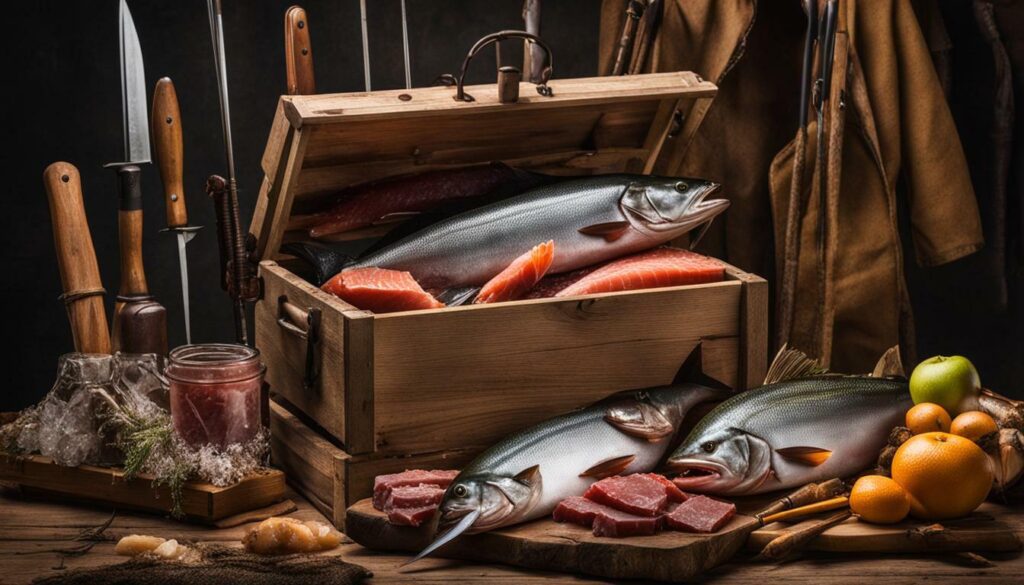

Preserving game meats and fish is an art form that allows you to enjoy the flavors of the hunt or the catch long after the season is over. Whether you choose to pickle, corn, or smoke your game meats and fish, these additional preservation methods will ensure they stay safe, flavorful, and ready to be enjoyed. So, don’t let your bounty go to waste – try these methods and savor the taste of the wild all year round.
Congratulations on completing this comprehensive guide on meat preservation
By now, you have discovered a variety of methods to preserve meat, from freezing and canning to curing and smoking, all with the goal of ensuring your meals are both safe and delicious for an extended period.
Throughout this guide, we have highlighted the importance of meat preservation for long-lasting storage. We have explored the principles of meat preservation, including curing methods, drying techniques, and the benefits of freezing meat. We have delved into the art of canning meat, providing step-by-step instructions for safe preservation. We have also discussed the flavors and preservation benefits of curing and smoking meat. Additionally, we have explored vacuum sealing and various meat drying techniques.
It is essential to note that the information in this guide is based on valuable sources such as the National Center for Home Food Preservation, which provides comprehensive guides on home canning and preservation of various food items. We have also referenced the book “The Complete Guide to Preserving Meat, Fish, and Game” by Kenneth V. Oster, which offers detailed instructions on freezing, canning, curing, and smoking different meats. Furthermore, the publication from NDSU Extension called “Preservation of Game Meats and Fish” provides recommendations for safely preserving game meats and fish using various methods.
Overall, this guide on meat preservation offers you valuable insights and techniques to preserve your meats in a safe and flavorful manner. Whether you choose to freeze, can, cure, smoke, or employ other preservation methods, these resources have provided you with the knowledge and expertise to ensure the longevity and quality of your preserved meats. Enjoy your preserved meats and the convenience they bring to your meals!
FAQ
What is meat preservation?
Meat preservation refers to the various methods used to extend the shelf life of meat and maintain its quality and flavor, preventing spoilage and food waste.
Why is meat preservation important?
Meat preservation is important because it allows for long-term storage of meat, ensuring that it remains safe to consume while retaining its taste and nutritional value.
What are some common meat preservation methods?
Common meat preservation methods include freezing, canning, curing, smoking, vacuum sealing, and drying. These methods help to preserve meat by preventing the growth of bacteria and slowing down the spoilage process.
How does freezing meat help with preservation?
Freezing meat helps to preserve it by slowing down the growth of bacteria and enzymes that can cause spoilage. It keeps the meat at a low temperature, which inhibits microbial growth and extends its shelf life.
What is the process of canning meat?
The process of canning meat involves cooking it and sealing it in sterilized jars. This creates an airtight environment that prevents the growth of bacteria and other microorganisms, preserving the meat for an extended period.
What is curing meat, and why is it done?
Curing meat involves treating it with salt, nitrates, or other ingredients to enhance its flavor and extend its shelf life. The curing process helps to inhibit the growth of bacteria, reduce moisture content, and add delicious flavors to the meat.
How does smoking meat help with preservation?
Smoking meat not only imparts a smoky flavor but also helps preserve it. The smoke acts as a natural preservative by inhibiting the growth of bacteria and mold, making the meat last longer while adding a delicious smoky taste.
What is vacuum sealing, and why is it beneficial for meat preservation?
Vacuum sealing is the process of removing air from the packaging to create an airtight seal. It helps to prevent oxidation and freezer burn, keeping the meat fresh for a longer period. It also helps to retain the meat’s natural juices and flavors.
What are some additional preservation methods for game meats and fish?
Additional preservation methods for game meats and fish include pickling, corning, and sausage making. These methods help to enhance the flavor and extend the shelf life of game meats and fish, ensuring they can be enjoyed for longer periods of time.
How can I ensure the safety of preserved meats?
To ensure the safety of preserved meats, it’s important to follow proper food safety guidelines, including using fresh, high-quality meats, practicing good hygiene during preparation, and adhering to recommended processing times and temperatures for each preservation method.

